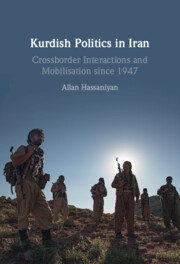Book contents
- Kurdish Politics in Iran
- Kurdish Politics in Iran
- Copyright page
- Dedication
- Contents
- Maps and Figures
- Acknowledgements
- Abbreviations
- 1 Introduction
- 2 Kurdish Nationalism: From Emergence to Politicisation
- 3 The Kurdish Peasant Revolt: the First Indication of Class Struggle
- 4 Movement Mobilisation through Crossborder Interaction
- 5 The 1979 Revolution and the Iranian Kurdish Movement
- 6 Khodmokhtari: the Focal Point of Kurdish–Regime Dispute
- 7 Internal Disintegration and Chaos
- 8 Decades of Decline and Uncertainty
- 9 Reform and Repression
- Conclusion
- Bibliography
- Index
9 - Reform and Repression
Published online by Cambridge University Press: 08 October 2021
- Kurdish Politics in Iran
- Kurdish Politics in Iran
- Copyright page
- Dedication
- Contents
- Maps and Figures
- Acknowledgements
- Abbreviations
- 1 Introduction
- 2 Kurdish Nationalism: From Emergence to Politicisation
- 3 The Kurdish Peasant Revolt: the First Indication of Class Struggle
- 4 Movement Mobilisation through Crossborder Interaction
- 5 The 1979 Revolution and the Iranian Kurdish Movement
- 6 Khodmokhtari: the Focal Point of Kurdish–Regime Dispute
- 7 Internal Disintegration and Chaos
- 8 Decades of Decline and Uncertainty
- 9 Reform and Repression
- Conclusion
- Bibliography
- Index
Summary
As discussed in Chapter 8, while the exiled section of the Iranian Kurdish movement experienced massive decline in its activity and was forced to passivity (kampnshini), the Kurdish civil society has in the 1990s and more recent decades innovated and experienced a new trend, known as the era of flourishing NGOs and civil society associations. Though emergence of this trend has been argued to be a development that emerged as result of the reform era under Mohammad Khatami’s presidency (1997-2005), the evolution, politicisation and discourse of Kurdish civil society has been unique to this region and has cherished Kurdish nationalism, culture and language. However, as this chapter highlights, another aspect of this development is that through the latest two decades Kurdistan has entered into a new phase of securitisation, expressed through mass arrests, persecutions and executions of Kurdish journalists, civil society and human rights activists, etc. Securitisation of the Kurdish region has been a development intensified through Mahmud Ahmadinejad’s (2005-13) and Hasan Rouhani’s presidencies (2013-).
- Type
- Chapter
- Information
- Kurdish Politics in IranCrossborder Interactions and Mobilisation since 1947, pp. 183 - 203Publisher: Cambridge University PressPrint publication year: 2021



